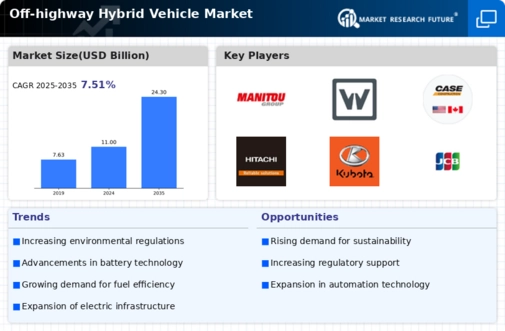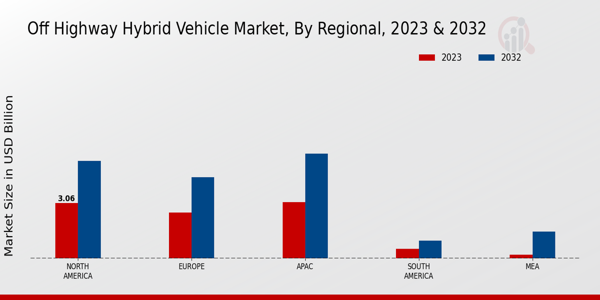Regulatory Support
Government regulations aimed at reducing emissions and promoting sustainable practices are significantly influencing the Global Off-highway Hybrid Vehicle Market Industry. Many countries are implementing stringent emission standards that necessitate the adoption of hybrid technologies. For example, the European Union has set ambitious targets for reducing greenhouse gas emissions, which encourages manufacturers to invest in hybrid vehicle development. This regulatory environment is likely to propel the market, with projections indicating a growth trajectory that could see the market expand to 24.3 USD Billion by 2035, driven by compliance with these regulations.
Rising Fuel Prices
The escalating prices of fossil fuels are a critical driver for the Global Off-highway Hybrid Vehicle Market Industry. As fuel costs continue to rise, operators in sectors such as mining and agriculture are increasingly seeking cost-effective alternatives. Hybrid vehicles, which offer improved fuel efficiency, present a viable solution to mitigate operational costs. This trend is expected to contribute to a compound annual growth rate of 7.51% from 2025 to 2035, as businesses prioritize investments in hybrid technologies to enhance their economic viability while reducing their carbon footprint.
Market Growth Projections
The Global Off-highway Hybrid Vehicle Market Industry is poised for substantial growth, with projections indicating a market size of 11.0 USD Billion in 2024 and an anticipated increase to 24.3 USD Billion by 2035. This growth trajectory suggests a compound annual growth rate of 7.51% from 2025 to 2035, reflecting the increasing adoption of hybrid technologies across various sectors. The market dynamics are influenced by factors such as technological advancements, regulatory support, and rising fuel prices, which collectively contribute to the expanding hybrid vehicle landscape.
Technological Advancements
The Global Off-highway Hybrid Vehicle Market Industry is experiencing a surge in technological advancements that enhance vehicle efficiency and performance. Innovations in hybrid technology, such as improved battery systems and energy management software, are driving the adoption of hybrid vehicles in off-highway applications. For instance, manufacturers are integrating advanced telematics systems that optimize fuel consumption and reduce emissions. As a result, the market is projected to reach 11.0 USD Billion in 2024, reflecting the growing demand for sustainable solutions in sectors like construction and agriculture.
Enhanced Operational Efficiency
The pursuit of enhanced operational efficiency is driving the Global Off-highway Hybrid Vehicle Market Industry. Hybrid vehicles are designed to optimize performance in challenging terrains, making them ideal for off-highway applications. By combining traditional engines with electric propulsion, these vehicles can achieve better torque and power management, which is crucial for heavy-duty tasks. This operational advantage is attracting investments from various sectors, including agriculture and construction, as companies seek to improve productivity while minimizing environmental impact. The ongoing focus on efficiency is expected to sustain market growth in the coming years.
Increased Demand for Sustainability
There is a growing global emphasis on sustainability, which is significantly impacting the Global Off-highway Hybrid Vehicle Market Industry. Stakeholders, including consumers and corporations, are increasingly prioritizing environmentally friendly practices. This shift is prompting manufacturers to develop hybrid vehicles that not only meet operational needs but also align with sustainability goals. The market's response to this demand is evident, as companies are launching hybrid models that reduce emissions and enhance energy efficiency. This trend is likely to foster further growth in the sector, as sustainability becomes a core component of business strategies.














